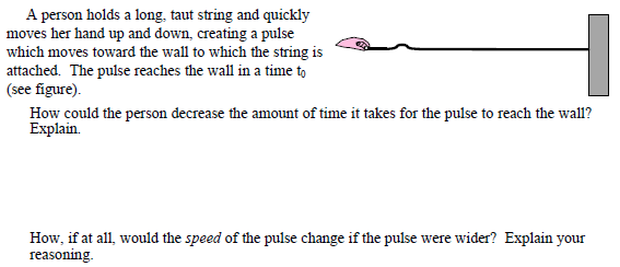Developed by Michael Wittmann
| Purpose | To help you, the instructor, understand your students’ thinking about basic wave concepts. |
|---|---|
| Format | Pre/post, Multiple-choice, Multiple-response, Short answer |
| Duration | Long: 30 min, Short: 15 min |
| Focus | Waves / Optics Content knowledge (waves) |
| Level | Intermediate, Intro college, High school |
Sample question from the WDT:

WDT Implementation and Troubleshooting Guide
Everything you need to know about implementing the WDT in your class.
Login or register to download the implementation guide.
more details
This is the second highest level of research validation, corresponding to at least 5 of the validation categories below.
Research Validation Summary
Based on Research Into:
- Student thinking
Studied Using:
- Student interviews
- Expert review
- Appropriate statistical analysis
Research Conducted:
- At multiple institutions
- By multiple research groups
- Peer-reviewed publication
To determine whether the WDT accurately tests students' conceptual knowledge of waves, Wittmann analyzed the pre- and post-test data for trends in student response patterns. Previous research has shown that students think of waves as having object-like properties rather than event-like properties, leading to incorrect reasoning about many questions regarding wave phenomena. Wittmann's pre-test data agreed with this, showing a high degree of object-like thinking among students. After instruction, post-test data shows an increase in event-like responses, which was one of the goals of the class. This means that the WDT identifies student misconceptions and can demonstrate student success after instruction, lending credibility to the test as a whole.
References
- A. Tongchai, M. Sharma, I. Johnston, K. Arayathanitkul, and C. Soankwan, Developing, Evaluating and Demonstrating the Use of a Conceptual Survey in Mechanical Waves, Int. J. Sci. Educ. 31 (18), 2437 (2009).
- M. Wittmann, Making Sense of How Students Come to an Understanding of Physics: An Example from Mechanical Waves, University of Maine, 1998.
- M. Wittmann, R. Steinberg, and E. Redish, Understanding and affecting student reasoning about sound waves, Int. J. Sci. Educ. 25 (8), 991 (2003).
- M. Wittmann, R. Steinberg, and E. Redish, Making sense of how students make sense of mechanical waves, Phys. Teach. 37 (1), 15 (1999).
We don't have any translations of this assessment yet.
If you know of a translation that we don't have yet, or if you would like to translate this assessment, please contact us!
| Typical Results |
|---|
Typical results from the WDT are difficult to report. The questions used regarding the motion of a dust particle or candle flame in front of a speaker turn out to be difficult to assess as right or wrong, because the real-world behavior of these systems is very complicated. However, this does not mean that student responses are meaningless. The strength of the WDT is not in determining whether students can give the right answer. Rather, it elicits rich and varied responses from students that show what they believe about waves and why. This makes the WDT very useful as a benchmark, and allows you to more accurately tailor your instruction to the incoming beliefs of your students. |
The latest version of the WDT by Wittmann, released in 1999, is version 1. In 2006, Tongchai et al. developed another version, which they call WDT4T, in which they added an additional subtopic: standing waves. Tongchai et al. have also developed a multiple-choice version of the WDT, known as the Mechanical Waves Conceptual Survey (MWCS).
Variations
|
|
Mechanical Wave Conceptual SurveyContent knowledge Waves / Optics (mechanical waves, wave propagation, wave superposition, wave reflection, standing waves)Intermediate, Intro college, High school Pre/post, Multiple-choice, Multiple-response |
|
|
Mechanical Waves Conceptual Survey 2Content knowledge Waves / Optics (propagation, superposition, reflection, standing waves)Intro college Pre/post, Multiple-choice |



